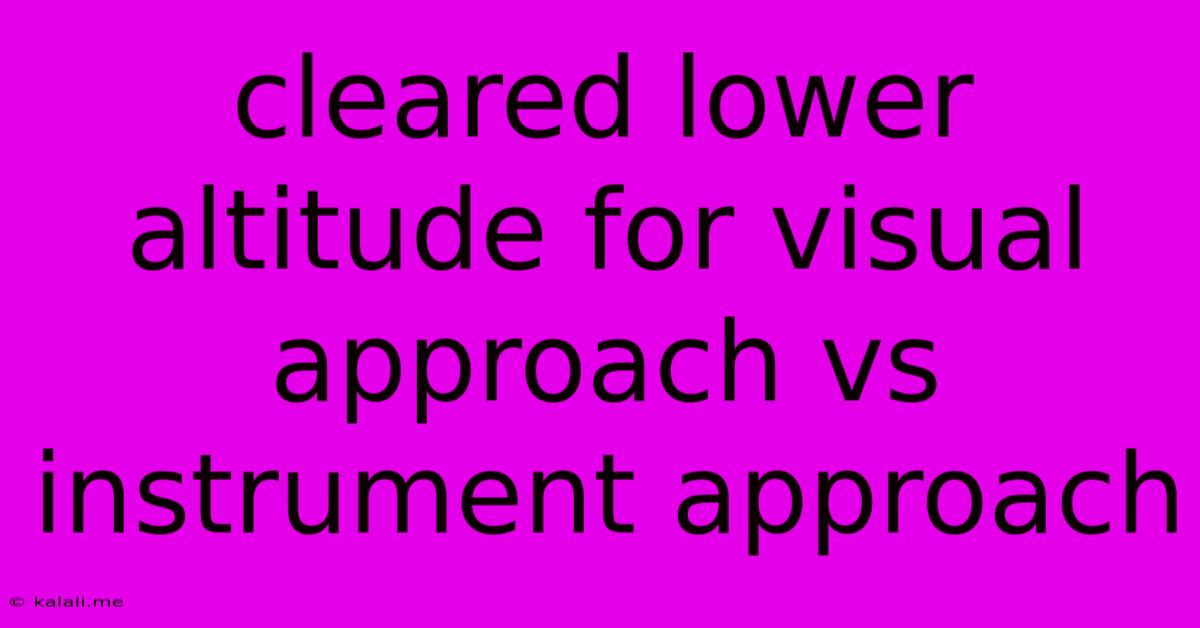Cleared Lower Altitude For Visual Approach Vs Instrument Approach
Kalali
May 31, 2025 · 3 min read

Table of Contents
Cleared for a Visual Approach vs. an Instrument Approach: Understanding the Differences
Pilots often hear "cleared for a visual approach" or "cleared for an instrument approach" from air traffic control (ATC). Understanding the key differences between these clearances is crucial for safe and efficient flight operations. This article clarifies the distinctions, highlighting the weather minimums, procedures, and pilot responsibilities involved in each.
What is a Visual Approach?
A visual approach is a flight maneuver conducted under visual flight rules (VFR) where the pilot uses visual cues—such as runways, taxiways, and landmarks—to guide the aircraft to a safe landing. This requires sufficient visibility and a clear view of the airport environment. It's a more straightforward approach, but heavily reliant on good weather conditions.
Weather Minimums for a Visual Approach:
- Visibility: Generally requires a minimum of 3 statute miles visibility. This can vary depending on the specific airport and its surrounding terrain.
- Ceiling: Usually requires a minimum cloud ceiling, often at least 1000 feet above the airport elevation. This provides sufficient clearance for safe maneuvering.
- Other factors: ATC may consider other factors like the pilot’s experience and the airport's complexity before clearing a visual approach.
Pilot Responsibilities During a Visual Approach:
- Maintain Visual Contact: The pilot must maintain continuous visual contact with the runway and surrounding areas throughout the entire approach.
- Abort if Necessary: If the pilot loses visual contact or encounters unfavorable conditions, they must immediately initiate a missed approach procedure.
- Adherence to ATC Instructions: Pilots must strictly follow any instructions given by ATC.
- Careful Navigation: Precise navigation is required to ensure a safe landing within the designated runway.
What is an Instrument Approach?
An instrument approach is conducted under instrument flight rules (IFR) and utilizes navigational aids like ILS (Instrument Landing System), VOR (VHF Omnidirectional Range), or GPS (Global Positioning System) to guide the aircraft to a safe landing, especially in low visibility conditions. This approach relies on instruments rather than visual cues.
Weather Minimums for an Instrument Approach:
Weather minimums for instrument approaches are significantly lower than for visual approaches and vary drastically depending on the specific approach type (ILS, RNAV, VOR, etc.) and the airport’s infrastructure. These minimums are specified in the airport's approach charts and are often much lower than VFR minimums, allowing for landings in conditions that would be unsafe for a visual approach. For example, a precision approach like ILS may have minimums as low as 200 feet ceiling and ½ mile visibility.
Pilot Responsibilities During an Instrument Approach:
- Instrument Proficiency: The pilot must be instrument-rated and proficient in using their aircraft’s instruments and navigation systems.
- Adherence to Approach Charts: Precise adherence to the designated approach procedures and altitudes as published in the instrument approach charts is mandatory.
- Monitoring Instruments: Continuous monitoring of instruments is crucial for maintaining the correct flight path and altitude.
- Communication with ATC: Clear and concise communication with ATC is vital throughout the entire procedure.
- Missed Approach Procedures: Pilots must be prepared to execute a missed approach procedure if they fail to meet the approach criteria.
Key Differences Summarized:
| Feature | Visual Approach | Instrument Approach |
|---|---|---|
| Weather | Requires good visibility and ceiling | Can be conducted in low visibility and ceilings |
| Guidance | Visual cues (runway, landmarks) | Navigational aids (ILS, VOR, GPS) |
| Regulations | VFR | IFR |
| Pilot Skills | VFR proficiency | IFR proficiency (instrument rating required) |
| Risk | Higher risk in adverse weather conditions | Lower risk in adverse weather conditions |
Choosing between a visual and instrument approach depends entirely on the prevailing weather conditions and the pilot's qualifications and equipment. Always prioritize safety and adhere to all regulations and ATC instructions. Understanding these crucial differences is paramount for every pilot to ensure safe and successful flights.
Latest Posts
Latest Posts
-
How To Increase Voltage In Circuit
Jun 02, 2025
-
Service Entrance Cable For 100 Amp Service
Jun 02, 2025
-
How To Give Myself A Mending Book
Jun 02, 2025
-
What To Do When A Teacher Doesnt Teach In University
Jun 02, 2025
-
Why Is My Friend Ignoring Me
Jun 02, 2025
Related Post
Thank you for visiting our website which covers about Cleared Lower Altitude For Visual Approach Vs Instrument Approach . We hope the information provided has been useful to you. Feel free to contact us if you have any questions or need further assistance. See you next time and don't miss to bookmark.